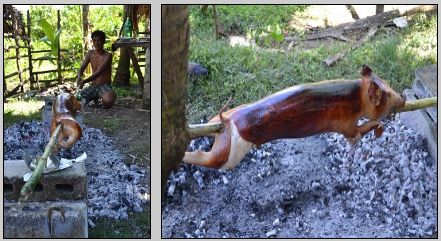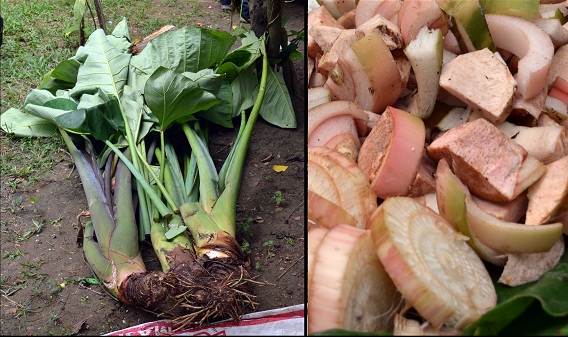The Philippine native swine is growing in popularity as the top choice meat for the traditional “lechon” delicacy in the country. With the increasing market demand for native lechon de leche, coconut farmers in the area are presented with a rare opportunity to earn extra income with only minimum investment capital.

Compared to commercial hogs, the Philippine native swine grows much smaller and but its meat compact. Mostly in speckled or solid dark hues (black, grey, and/or brown), native pigs are known to be highly resilient to extreme weather changes and diseases common to their pastel-colored counterparts. This attribute plus their availability in the province makes the native swine a prime candidate in the development of the lechon de leche industry in Quezon. And to be able to produce organic lechon, feed also needs to be not only organic, but highly affordable for the farmer communities to sustain.
Conventional feed is available, but with limited results. Composed mainly of a number of local and imported ingredients such as corn, soybean meal, animal gut and bones, synthetic vitamins and minerals, plus antibiotics, use of ready-made feeds prove to be less advantageous for farmers. With these expensive ingredients, factor in packaging costs and other expenses incurred by the manufacturers, these feeds prove to be pricey for regular supply. Synthetic ingredients further pose unattractive results to the taste of the meat. Not to mention the availability issues in isolated provinces throughout the country. And in order to make native swine production attractive to our farmers, issues in feeding must be addressed.
In the project, “Native Swine for “Lechon de Leche” Production: Improving Feed Availability Through Integration of Sakwa as Forage Feed in Coconut-based Production Systems” launched in 2008, with lead proponents Ms. Mary Jean G. Bulatao and Mr. Virgilio T. Villancio of the University of the Philippine Los Baños (UPLB), native swine production and organic forage feed comes into focus.
Funded by the Bureau of Agricultural Research (BAR) under its National Technology Commercialization Program (NTCP), the project aimed to provide additional income for coconut farmers and increase their productivity in the province of Quezon, specifically in the municipalities of Mulanay and San Narciso. It also hoped to utilize the resources readily available to the farmer cooperators-this being the native pigs, and the possible feed they can provide that is both affordable and organic.

Sakwa: Cheap, organic feed Gabing San Fernando (Yautia sp.) is a fairly adaptable crop, thriving almost in any type of soil abundant in organic matter and can withstand any moderate weather condition, without needing chemical fertilizer or any synthetic nutrient additives. Sakwa is the corm of gabing San Fernando and is just the by-product of the crop. With gabing San Fernando being cultivated primarily to produce halaya and used as ingredient in other human food products, utilizing sakwa as forage feed does not demand added effort for cultivation and even lessens wastage. Although research has demonstrated that the crude protein content of sakwa is comparable to corn (7.67 percent vs. 8.5 percent), farmers were not aware of the possibilities of sakwa as forage feed ingredient and corn substitute, until the project of Bulatao, Villancio, and BAR.
“Pwede shang itanim ng pangkaraniwang magsasaka dito sa ating lugar” (“It can be grown by ordinary farmers in our area”), shares Villancio.
The project encouraged backyard planting of gabing San Fernando without the use of any chemical fertilizer. By combining sakwa with other plants such as the trichanthera and ipil ipil leaves and vegetables undergoing the same natural growing process, a nutrient-filled feed becomes readily available to the community-without additional cost. Positive results from testimonies of farmer cooperators and further studies by Bulato and Villancio indicate that sows even produce more milk for breastfeeding after being fed sakwa meal.
As a result of this, farmer cooperators around Mulanay and San Narciso have begun planting gabing San Fernando under their coconut trees where their native pigs are able to move about and feed thus, ensuring that Quezon’s native swine production remains true to its simple and organic beginnings.
By: Zuellen B. Reynoso, Bar Digest July-September 2011 Issue (Vol. 13 No. 3)


I think ,I have to start first the housing of native pigs,and choose the best material of it…where can we buy a good materials at least 5 lady native pigs and 1 male pig
Want part time or Full time job?? Work from the safety of your own home.
Email me at [email protected]
For more details kindly visit www.unemployedpinoys.com